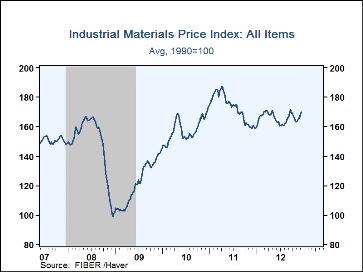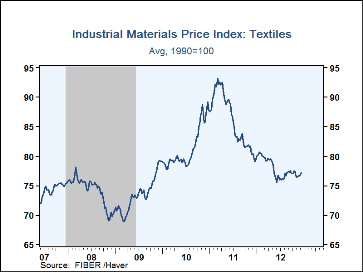 Global| Dec 19 2012
Global| Dec 19 2012FIBER: Commodity Prices Hold Firm
by:Tom Moeller
|in:Economy in Brief
Summary
Industrial commodity prices have shown upward movement of late despite signs of weakening growth in factory sector output. At 171.2, the latest price index from the Foundation for International Business and Economic Research (FIBER) [...]
Industrial commodity prices have shown upward movement of late despite signs of weakening growth in factory sector output. At 171.2, the latest price index from the Foundation for International Business and Economic Research (FIBER) was just off its highs for the year and up 8.3% from late 2011. During the last ten years there has been a 44% correlation between the three-month change in prices and the change in factory sector industrial production.
 Overall, the performance of commodity prices belies the notion of
material softness in the U.S. industrial sector. Current weakness may be
more due to the temporary effects of Hurricane Sandy which are will lower
Q4 growth in real GDP to roughly one percent according to economists'
estimates. Thereafter, projections call for economic improvement, but
whether it will be enough to materially lift industrial commodity prices
remains to be seen.
Overall, the performance of commodity prices belies the notion of
material softness in the U.S. industrial sector. Current weakness may be
more due to the temporary effects of Hurricane Sandy which are will lower
Q4 growth in real GDP to roughly one percent according to economists'
estimates. Thereafter, projections call for economic improvement, but
whether it will be enough to materially lift industrial commodity prices
remains to be seen.
Still leading the improvement were prices in the miscellaneous group. The gain reflected surging prices for framing lumber (37.4% y/y) and structural panels (45.4% y/y). In the metals group, earlier declines in aluminum (10.6% y/y) and copper scrap (9.8% y/y) have stabilized. Declines in the textile group also have stabilized though cotton prices remain down 14.6% y/y. Crude oil prices (-6.6% y/y) have been weak but remain higher than the February low
Commodity price data can be found in Haver's DAILY, WEEKLY, USECON and CMDTY databases.
| FIBER Industrial Materials Price Index (1990=100) | 12/19/12 | Y/Y % | 2011 | 2010 | 2009 |
|---|---|---|---|---|---|
| All Items | 171.2 | 8.3 | 172.9 | 157.7 | 121.4 |
| Textiles | 77.4 | -2.4 | 86.1 | 81.2 | 73.3 |
| Cotton (cents per pound) | 71.4 | -14.6 | 132.6 | 87.8 | 52.2 |
| Metals | 253.3 | 8.5 | 278.5 | 239.9 | 167.9 |
| Aluminum ($ per metric ton) | 2,163.0 | 10.6 | 2,400 | 2,172 | 1,662 |
| Copper Scrap (cents per pound) | 362.8 | 9.8 | 400.1 | 326.5 | 195.2 |
| Steel Scrap ($ per ton) | 349.7 | -12.9 | 412.4 | 325.7 | 203.4 |
| Crude Oil & Benzene | 205.6 | 5.9 | 199.3 | 182.0 | 150.9 |
| Crude Oil (WTI, $ per Barrel) | 87.7 | -6.6 | 95.1 | 79.5 | 61.4 |
| Miscellaneous | 216.6 | 19.2 | 190.5 | 178.8 | 127.6 |
| Framing Lumber ($ per 1000 board ft.) | 364 | 37.4 | 273 | 282 | 221 |
| Natural Rubber (cents per pound) | 200.5 | -3.3 | 261.8 | 181.8 | 83.0 |
Tom Moeller
AuthorMore in Author Profile »Prior to joining Haver Analytics in 2000, Mr. Moeller worked as the Economist at Chancellor Capital Management from 1985 to 1999. There, he developed comprehensive economic forecasts and interpreted economic data for equity and fixed income portfolio managers. Also at Chancellor, Mr. Moeller worked as an equity analyst and was responsible for researching and rating companies in the economically sensitive automobile and housing industries for investment in Chancellor’s equity portfolio. Prior to joining Chancellor, Mr. Moeller was an Economist at Citibank from 1979 to 1984. He also analyzed pricing behavior in the metals industry for the Council on Wage and Price Stability in Washington, D.C. In 1999, Mr. Moeller received the award for most accurate forecast from the Forecasters' Club of New York. From 1990 to 1992 he was President of the New York Association for Business Economists. Mr. Moeller earned an M.B.A. in Finance from Fordham University, where he graduated in 1987. He holds a Bachelor of Arts in Economics from George Washington University.










